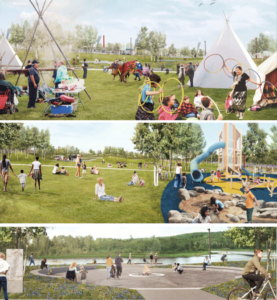
Urban Systems was awarded a large and significant project in one of our home communities, Fort McMurray. The Waterfront Park Revitalization Project spans 6km from the western edge of the Athabasca Bridge and follows the water along the Snye and Clearwater River to the existing Horse Pasture Park in Waterways in the Regional Municipality of Wood Buffalo (RMWB). It also includes notable engagement with the Indigenous communities in the region, and integration of many of our technical practices from landscape architecture to flood mitigation to active transportation. Our team has partnered with an incredible landscape architecture firm from Toronto for this work; DTAH.
Working alongside another Landscape Architecture firm for this project produces great benefits, both for Urban Systems and Fort McMurray. DTAH has established a solid reputation for providing insightful design solutions to often complex problems. Major clients include the City of Toronto, City of Hamilton, Waterfront Toronto, RCMP, National Capital Commission, Public Works Canada, Canada Lands Company, Metrolinx, Infrastructure Ontario, University of Toronto, and Carleton University. This Waterfront Park revitalization project provides a unique opportunity to create a relationship with this eastern Canada firm that Urban can expand to future projects. This partnership enables us to provide our clients and places such as Fort McMurray with the best of both firms, delivering meaningful, innovative projects and creating vibrancy in these communities.
Fort McMurray’s waterfront is defined by its rich history, its dramatic natural beauty, and its bright future as a dynamic community resource. The site provides an opportunity to enhance and redefine the relationship to the water’s edge, to create meaningful outdoor spaces for the enjoyment of residents, businesses, and visitors. This project will transform and revitalize the waterfront into a local and regional destination. The project area spans from the western edge of the Athabasca Bridge and follows the water along the Snye and Clearwater River to the existing Horse Pasture Park in Waterways. Interestingly, a large majority of the park area is in an existing flood plain, with rich natural habitats. The park systems will include festival grounds (outdoor event space), recreation and play areas, destination nodes, amenities, public art, cultural and heritage recognition, and other elements, as well as consideration for key connections to the waterfront.
Recognizing the significant and regional history of the Waterfront, the project includes a dedicated focus on interpretive and cultural placemaking. This will include topics of Indigenous culture, settler heritage, river dynamics, industrial ecosystems, and biodiversity. The design of the Waterfront Park will reflect the Indigenous Peoples’ ties to the land since time immemorial, culturally significant areas such as Moccasin Flats, and centuries of stories encompassing exploration, fur trade, and the establishment of the Gateway to the Arctic.
The Waterfront Park Revitalization will have far reaching impact to the local community as well as positive regional influence. Through an integrated social and ecological approach and a strong emphasis on design excellence, the transformed waterfront will generate a pride of place. This will establish stewardship of the land and together with economic investment, will provide a cultural and recreational destination for generations to come.